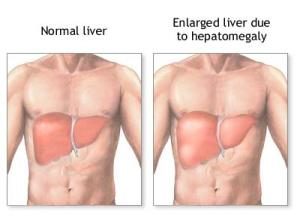
Hepatomegaly is a technical name for “enlarged liver.” As the name implies, it’s a condition in which the liver is enlarged or swollen. Rather than a disease in itself, hepatomegaly is a symptom or complication of other liver conditions, some of them life-
Liver disease can develop for years with no overt symptoms at all. Usually, if it’s detected early, liver disease is first diagnosed from blood tests for liver enzymes rather than from symptoms. When symptoms like hepatomegaly do show up, this usually means that the illness has progressed to a more serious and dangerous stage.
For this reason, the appearance of hepatomegaly is always a cause for significant medical concern, and efforts to diagnose the precise cause of the symptom are highly recommended.
Causes
There are a lot of different causes of hepatomegaly –
Liver disease in turn has underlying causes. The single most common cause of liver disease is alcohol abuse. Other causes include infections (especially the viral infections that cause infectious hepatitis), obesity, diabetes, hereditary factors, and the effects of drugs, both medicinal and non-
Diagnosis
Hepatomegaly is initially diagnosed either by visible or tangible swelling in the upper abdominal area, indicating a swollen liver, or by medical imaging which allows the swollen liver to be clearly seen. Such testing often follows after a preliminary diagnosis of possible liver disease arising from a liver enzyme blood test.
Differential Diagnosis
When hepatomegaly is identified, the degree of swelling is identified as mild, moderate, or massive, with possible causes grouped under each heading.
Possible causes of massive hepatomegaly include cancer (either primary in the liver or metastasized from elsewhere in the body), right-
Moderate hepatomegaly can result from any of the same causes as massive hepatomegaly (i.e., the same underlying impairment can produce less pronounced swelling of the liver), and also from hemochromatosis (excess iron in the body), fatty liver, and more moderate stages of liver diseases such as cirrhosis.
Mild hepatomegaly can result from any of the above causes, and also from hepatitis, biliary obstruction (obstruction of the bile ducts), tapeworm (hydatid disease), and HIV infection.
Hepatosplenomegaly
Hepatosplenomegaly refers to a condition in which both the liver and the spleen are enlarged simultaneously. This can happen as a result of acute viral hepatitis, infectious mononucleosis, a lung-
Treatment Of Hepatomegaly
Treatment of hepatomegaly always involves treatment of the underlying condition. In most cases, this in turn involves lifestyle changes, although in the case of liver cancer the proper treatments may include chemotherapy and other treatments for cancer. Alcoholic liver disease is treated by cessation of drinking alcohol. Non-
The final stages of liver disease can result in so much damage to liver function that the only way the patient can survive is with a liver transplant. This is true of end-
Hepatomegaly In Children
Although usually a disease of adults, hepatomegaly can also occur in children. The causes are sometimes the same as with adult hepatomegaly but others are different. Hereditary factors, viral infections, and cancer can occur in children as well as adults. Alcohol abuse is much less likely as a cause in children than in adults. There are some causes of hepatomegaly which only occur in childhood. One of these is Reye’s syndrome, which is a potentially fatal form of fatty liver disease caused by the use of aspirin to treat childhood fevers. Because of the danger of Reye’s syndrome, a substitute fever-